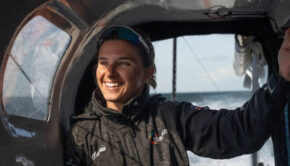The Impacts of Offshore One Design Racing
Published on May 18th, 2015
With wins in the Volvo Ocean Race and Barcelona World Race, as well as seven full trips around the globe, Damian Foxall (IRL) is one of the world’s most accomplished offshore sailors. In an interview on 48North.com, Damian comments on the impact of one design for the Volvo Ocean Race…
In the last Volvo Ocean Race (sailing with Groupama), our team had 50 people at the start of the race, and two years of training in Lorient with another boat. We bought Ericsson 4, trained on it, and designed our next race boat based on that. It was a massive amount of resources, human and financial, leading up to the start of the race. That creates an un-level playing field.
We ended up having a very fast boat, probably the fastest boat on the racecourse. And we ended up winning. But, I’ve already done the race with slow boats. And that’s tough, for the team, but most importantly for the sponsors.
It’s a great selling point to be able to say “This a level playing field. Whether we start two years or two months before the start of the race, one thing is for sure, we’re going to have the same boat as everyone else.” So, it was a no brainer, and a great decision by Knut (race CEO Knut Frostad). The boat’s not as high performance as it used to be, which I would say is a little bit of a disappointment.
One thing that the one design has done is shift the emphasis to the navigator and the skipper. Of course, it’s still important to have good trimmers and drivers, and the best teams will be winning. But, the main difference will be the consistency and coherency of the strategy and the tactics of the skipper and the navigator. And that’s what we’re seeing.
On paper, Dongfeng is a great team, but most people wouldn’t know who they are. There’s only 6 professional sailors on board, the others are young Chinese guys. They’re already at a disadvantage. Well, the importance of that has been reduced. And the skipper and navigator on Dongfeng are two of the best offshore sailors you could find. And they know each other, and they also have a cultural advantage in that they have grown up on the Figaro circuit, racing offshore in one design fleets. And, for some reason, they are fast. They’re sailing really well.









 We’ll keep your information safe.
We’ll keep your information safe.